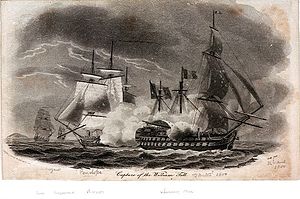 Capture of the William Tell, by Robert Dodd
| |
| History | |
|---|---|
| Name | Guillaume Tell |
| Builder | Toulon |
| Laid down | September 1794 |
| Launched | 21 October 1795 |
| Completed | By July 1796 |
| Captured | 30 March 1800, by the Royal Navy |
| Name | HMS Malta |
| Acquired | 30 March 1800 |
| Fate | Broken up in August 1840 |
| General characteristics | |
| Class and type | Tonnant-class ship of the line |
| Tons burthen | 2,265 9⁄94 bm |
| Length |
|
| Beam | 51 ft 7.5 in (15.7 m) |
| Depth of hold | 23 ft 4 in (7.11 m) |
| Propulsion | Sails |
| Sail plan | Full-rigged ship |
| Complement | 780 |
| Armament |
|
HMS Malta was an 80-gun third rate ship of the line of the Royal Navy. She had previously served with the French Navy as the Tonnant-class Guillaume Tell, but was captured in the Mediterranean in 1800 by a British squadron enforcing the blockade of French-occupied Malta. Having served the French for less than four years from her completion in July 1796 to her capture in March 1800, she would eventually serve the British for forty years.
Guillaume Tell took part in the Battle of the Nile, but formed part of the rear of the French fleet and saw little action. She became one of only two French ships of the line to escape the destruction of the fleet, and took refuge at Malta. She was trapped there by the British blockade, and as the island began to fall to the British, she attempted to escape. She was spotted by a patrolling British frigate and attacked, with nearby British ships of the line joining the action. After a fierce fight she struck her colours and was taken by the British. Renamed HMS Malta after the island she was captured off she served in the Channel, the Atlantic and the Mediterranean. She fought with Vice-Admiral Robert Calder's fleet at the Battle of Cape Finisterre in 1805, contributing to the capture of two enemy ships. Transferred to take part in the blockade of the French ports, she helped in the chase and capture of the French frigate Président in 1806. The last years of the war were spent as a flagship in the Mediterranean, after which she returned to Britain. She spent some time as the Plymouth guardship, and remained on active service until being reduced to a harbour depot ship, in which role she spent nearly a decade. She was finally broken up in 1840, forty years after her capture from the French.